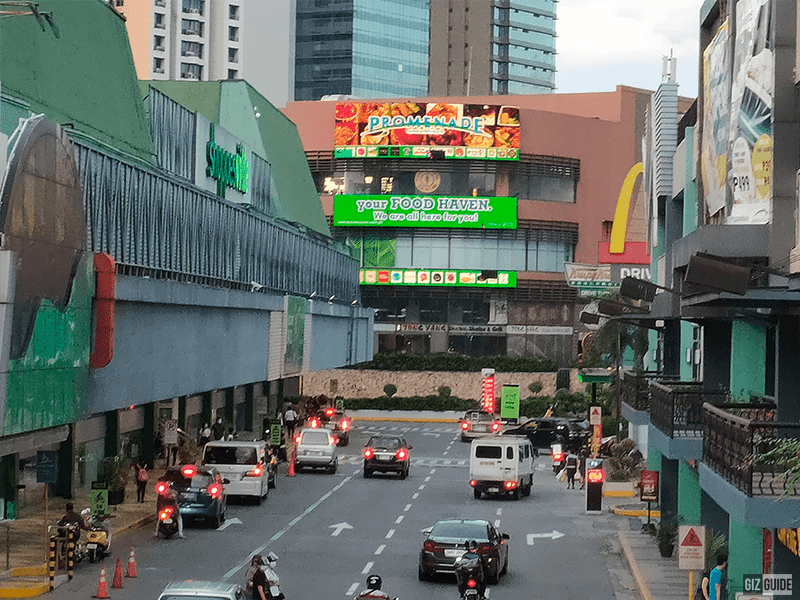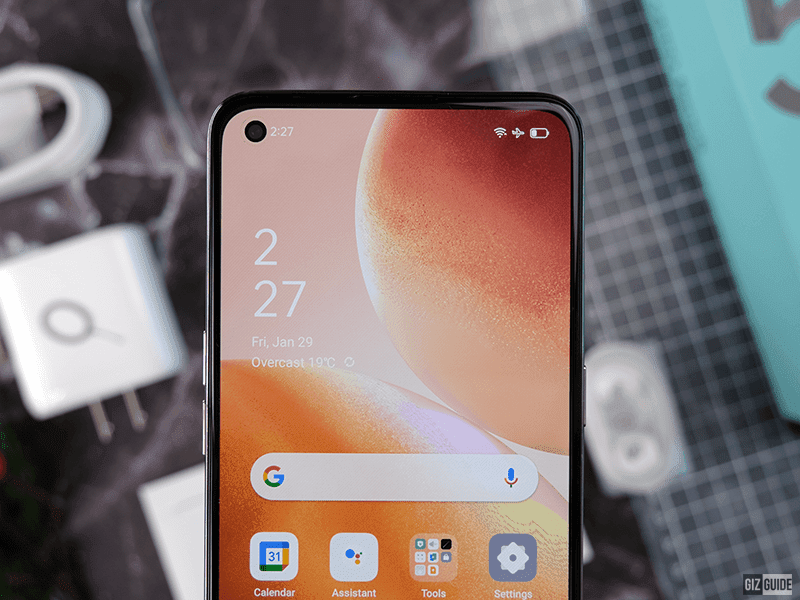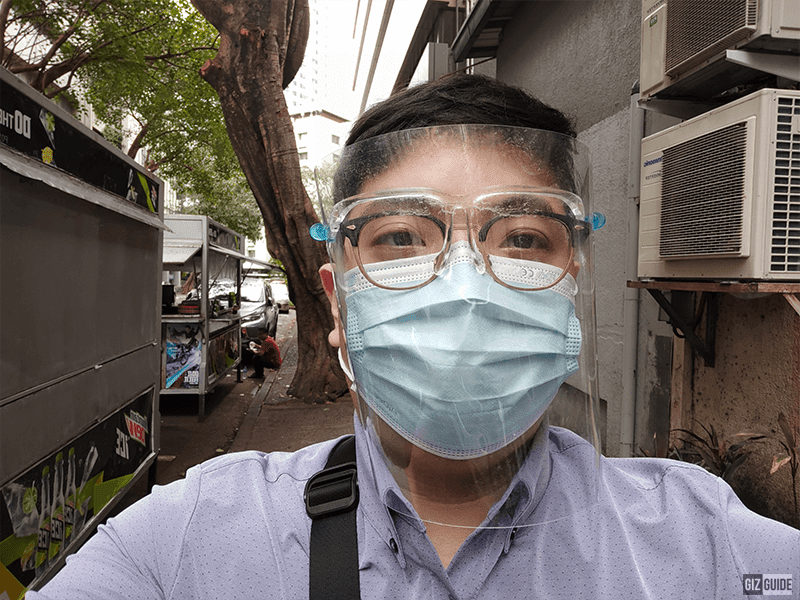.gif)
We share our experience with the OPPO Reno5 4G after over 2 weeks of daily use. This is our review of the new mid-ranger!
 |
| OPPO Reno5 4G in Fantasy Silver |
Announced in early February, the OPPO Reno5 5G and Reno5 4G is finally arriving in the Philippines.
The LTE only version comes with a 6.4-inch AMOLED display with a 90Hz refresh rate, FHD+ resolution, and Gorilla Glass 3 protection. Inside is the Qualcomm Snapdragon 720G octa-core processor, Adreno 618 GPU, 8GB LPDDR4X RAM, 128GB UFS 2.1, and 4,310mAh battery with 50W SuperVOOC Flash Charge via USB-C.
The Reno5 4G is priced at PHP 18,999 and is now available at OPPO stores nationwide.
Let's see how it performs after 2 weeks of use.
Multimedia Experience
 |
| Netflix on Reno5 4G |
In front of Reno5 4G is the large 6.4-inch AMOLED display with 2400 x 1080 resolution, 90Hz refresh rate, and Gorilla Glass 3. This means it has a dense 411 ppi which results in crisp text and sharp images. The display is bright enough to be readable under direct sunlight and the images on the display have vibrant color and good contrast.
 |
| Display settings |
The 90Hz refresh rate makes navigating thru the OS or playing games look and feel smoother and more responsive.
90Hz AMOLED screen under PHP 20K!
Lastly, the 10-point touch screen is quick, responsive, and accurate. We didn't notice any delay, misread taps or gestures. OPPO has also been generous enough to let the user decide if they want to somewhat hide the punch hole or if they want to have apps on full-screen or not. It's good that OPPO gives its users more control.
We are satisfied with the display overall.
 |
| Top and bottom view |
On the top left side of the display is the front-facing selfie camera.
Above the display is a thin slit where the earpiece is located. It is slim enough to be hidden and will only be found when you are intentionally looking for it.
At the bottom of the phone are the speaker grill, USB Type-C, a microphone port, and a 3.5mm audio jack.
The earpiece is exclusively for calls only while the bottom-firing speaker produces a mono sound with decent maximum volume. It does distort at maximum volume but the quality is mostly consistent across the volume range.
The microphone recording with the OPPO Reno5 4G is good. The noise cancellation is good enough that gives our callers little to complain about voice quality.
Cameras
 |
| Rear camera module |
At the back of the Reno5 4G is the rear-quad camera module made of a 64MP f/1.7 main camera, 8MP f/2.2 119-degree ultra-wide-angle camera, 2MP f/2.4 macro camera, and 2MP f/2.4 monochrome camera with LED flash.
It is quite impressive that OPPO was able to limit the size of the camera module while making it look stunningly eye-catching.
The new camera app includes modes like Photo, Video, Night, Portrait, Expert, Macro, Pano, Slo-Mo, Time-lapse, AI Mixed Portrait, Extra HD, Text Scanner, Sticker, and Soloop templates.
A new addition is the Dual-view video which allows the user to record video using the front-facing camera and the rear-facing main camera simultaneously. Users have the option to record in Split, Round, and Rectangle modes. Live face beautification in this video mode is also available.
The Expert mode allows for control of ISO (100-6400), Shutter Speed (1/8000-32 secs), White Balance, exposure compensation (+-2 stops), and focus. There is no control for metering modes. Expert mode has access to 1x, 2x, and 5x zoom.
Rear Camera Samples
 |
| Main camera daylight |
 |
| 2x telephoto camera daylight |
 |
| 5x telephoto camera daylight |
|
 |
| 10x telephoto camera daylight |
 |
Ultra-wide camera daylight
|
In daylight, the main, 2x, 5x and digital 10x telephoto, and ultra-wide cameras produce good images that are sharp, detailed, and vibrant. Impressive images. Our only concern with the images is that the colors are too vibrant for our taste and there are some visible noise and grain in shadow areas. This can be corrected in firmware. We hope OPPO can adjust these.
 |
| Main-camera close-up |
 |
| Macro camera |
The main camera can also take pictures with the subject up close and the minimum focusing distance is moderate. It isn't for macro-like distances.
The Macro camera is able to take pictures super close to the subject. The images from this are decently sharp and clean from afar but when zooming-in, the grain, and the imperfections become more apparent. This is expected from a 2MP sensor.
In low-light, all cameras have noticeably more grain. The main camera and the 2x telephoto maintain the sharpness and color accuracy while the rest of the cameras are noticeably softer especially the 10x telephoto's low light image.
 |
| Main camera night mode |
 |
| 2x telephoto night mode |
 |
| 5x telephoto night mode |
 |
| Ultra-wide camera night mode |
The rear camera's Night Mode is available for ultra-wide, main, 2x telephoto, and 5x telephoto. All four cameras have a noticeable improvement with a brighter exposure and bright areas or light sources have recovered color and detail.
 |
| Front-facing camera |
The 44MP f/2.4 selfie camera can be found on the top left side of the display. Camera modes include Photo, Video, Night, Portrait, AI mixed portrait, Pano, Sticker, Slo-Mo, and Time-lapse.
The camera app also features a screen flash feature if the user wants to improve the low light selfies.
The rear-facing camera can capture up to 4K at 30fps with EIS and up to 1080 slow motion while the selfie camera is able to record up to 1080 at 30fps with EIS and up to 1080 slow motion.
There is an Ultra Steady mode that locks the video recording up to 1080p at 30fps but improves the stability of the footage however the field of view is significantly cropped.
The user is free to use the ultra-wide, main, 2x, and 5x cameras in the video mode and it records good footage with sharp, detailed, vibrant, and contrasty footage. It may be one of the better footage in its price range.
Both the rear and front-facing cameras produce decently sharp and color-accurate video footage. Our main concern with the footage is that there is a lot of warping and distortion from the electronic stabilization which makes the footage disorienting and distracting. When using the telephoto cameras, the footage's rolling shutter is a lot more apparent.
We recommend using an external gimbal and turning off the electronic stabilization to get the most stable and smooth footage from the OPPO Reno5 4G's rear and front-facing camera.
These issues could be fixed via firmware. Hopefully, OPPO can fix them.
In summary, the front and rear cameras are versatile in stills but struggle with video recording.
 |
| AnTuTu and GeekBench benchmark results |
The Qualcomm Snapdragon 720G inside the Reno5 4G was able to score 289,818 in AnTuTu and to score 569 single-core and 1681 multi-core in Geek Bench 5.
 |
| 3DMark Wild Life benchmark |
In the new 3D Mark Wild Life benchmark, Reno5 4G scored 1050 overall with an average of 6.3 frames per second while keeping the temperature low.
 |
| Genshin Impact settings |
With the latest games like Genshin Impact, the Snapdragon 720G pushed the graphics settings to low but it is smooth and playable. We experience stuttering and frame rate drops when there are a lot of enemies and animations happening on screen. Otherwise, Genshin Impact is playable on the OPPO Reno5 4G. The back of the phone gets warm after around 90 to 120 minutes of continuous play.
 |
| Call of Duty: Mobile Settings |
In older games like NBA Live 2K20, the graphics and frame rate can be pushed high. While in Call of Duty: Mobile, the user can either push the frame rate to Max but be limited to High graphics only. Alternatively, you can only have very high on both the frame rate and the graphics quality. This is the limitation of the SoC.
 |
| Battery usage on two separate days |
Inside the OPPO Reno5 4G is a 4,310mAh battery that supports 50W Super VOOC Flash Charge via the USB Type-C port. There is no wireless charging support.
Good battery capacity, fast charging speed!
In our daily usage where we were constantly connected to WiFi, LTE, and 5G (when available) while doing our routine tasks where we use the phone to call, text, web surf, e-mail, stream music, and video, to play games, and to navigate with Waze, the Reno5 4G was able to last a full day of use with a little charge to spare. We would unplug the phone from the charger at 8 AM and at 8 PM we would get around 10 to 15 percent of the battery left. It can last a whole day but just barely.
With the included 50W Super VOOC charger, it takes around 50 minutes to charge the battery from 0 to 100 percent.
 |
| ColorOS UI |
Under the hood is ColorOS 11.1 that is based on Android 11. It features more minor visual tweaks along with several under-the-hood features. Visually, OPPO had decided to use square-ish icons with round corners. The app drawer, notification panel and the settings app have been cleaned up visually with better organization. This makes things look cleaner while making apps and settings easier to find. OS-wide Dark mode is a great addition as well.
The Snapdragon 720G is able to handle ColorOS 11.1 well. Navigating thru the OS and opening apps is snappy enough. It isn't as snappy as more expensive flagships, but the 90Hz display helps.
Both the face unlock and the In-Display fingerprint scanner set-up process are fast and straightforward. The face-unlock tech quickly detects my face and unlocks the phone as soon as the display is active. It is also able to detect my face even if I take off my glasses. It does struggle when you are trying to face unlock in a dim environment or when the user is wearing a mask.
The display brightens up to be able to compensate for this. It would be great if the Face Unlock has an alternative look feature for when the user is wearing a mask. Otherwise, the fingerprint scanner is best used when wearing a mask.
WiFi, Bluetooth, and LTE connections are stable. We've never experienced forced disconnections or the like while the GPS acquires our locations immediately and accurately.
Pros - Premium and solid build, unique design, 90Hz display, versatile cameras for photo and video, 50W fast charge, the battery is good for 90Hz display
Cons - Selfie video could be improved, Snapdragon 720G performance, video recording performance could be improved greatly
OPPO Reno5 4G Specs
Display: 6.4-inch 2.5D curved Gorilla Glass 3 AMOLED screen w/ 90Hz refresh rate, FHD+ 2400 x 1080 resolution at 411 ppi
CPU: 2.3GHz 8nm Snapdragon 720G octa-core processor
GPU: Adreno 618
RAM: 8GB LPDDR4X
ROM: 128GB UFS 2.1 expandable via microSD card up to 256GB
Back Camera: 64MP f/1.7 w/ PDAF and EIS + 8MP f/2.2 119-degree ultra-wide-angle + 2MP f/2.4 w/ 4cm macro + 2MP f/2.4 mono + LED flash
Selfie Camera: 44MP f/2.4
Battery: 4,310mAh w/ 50W SuperVOOC Flash Charge
OS: Android 11 w/ ColorOS 11.1
Connectivity: WiFi 802.11 a/b/g/n/ac (2.4GHz/5GHz), 4G LTE, Bluetooth 5.1 (SBC, AAC, aptX, aptX HD, LDAC), OTG, GPS, A-GPS, GLONASS, BeiDou, QZSS, Galileo, dual SIM
Sensors: Accelerometer, light, orientation, proximity, gyroscope, sound, magnetic
Others: In-Display fingerprint sensor, dual mic, Dolby Atmos, USB-C, Colors: Fantasy Silver, Starry Black
Dimensions: 159.1 x 73.3 x 7.7 mm
Weight: 171 g
Price: PHP 18,999
Verdict
 |
| Shades of Fantasy Silver |
The OPPO Reno5 4G offers similar performance in cameras and battery life as with the 5G version but at a more affordable price.
The compromise with SoC performance is there but the versatility of the cameras in photo and video, the super-fast 50W charging, and premium and solid build materials make it an attractive pick for people who are not looking for 5G connectivity yet.
If you are not picky about 5G connectivity and want a phone with a solid design, build quality, versatile stills cameras, and fast charging, the OPPO Reno5 4G could be for you.
We hope that OPPO will continue to improve the video recording performance of the front and rear cameras thru firmware updates.
Build/Design - 4.25
Multimedia Experience - 4.25
Cameras - 4
Performance - 4
Average - 4.125/5
What do you guys think?

.gif)
























































Post a Comment